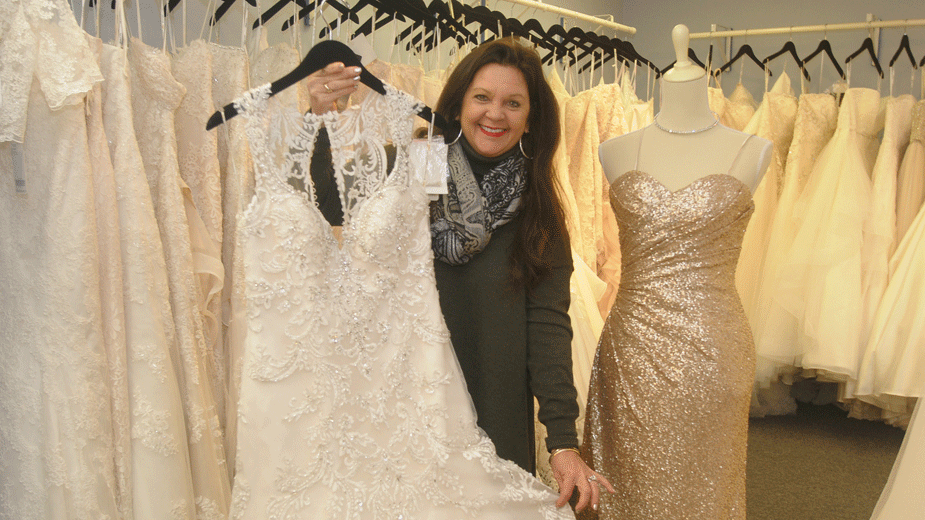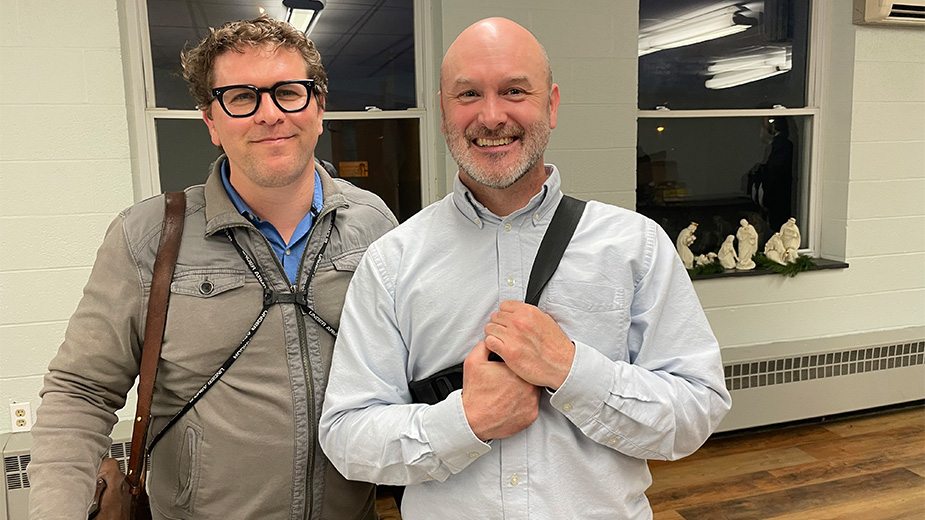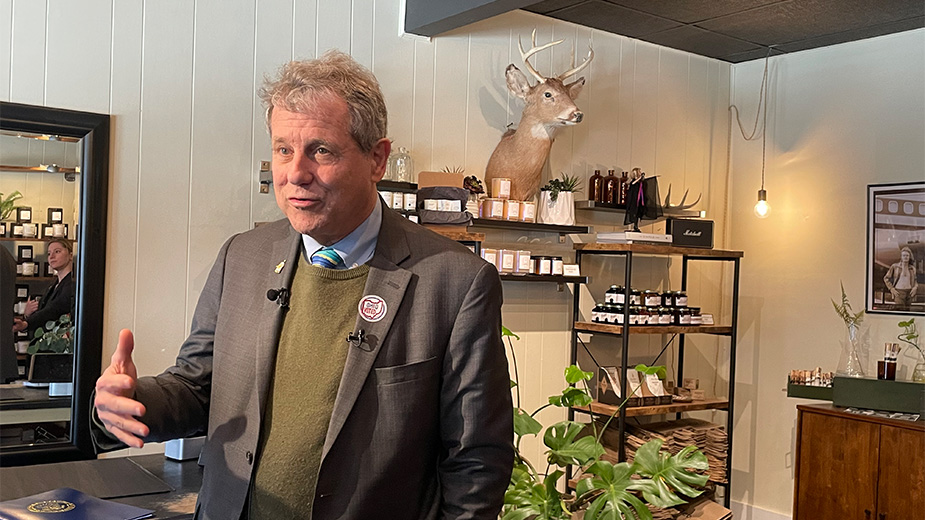They Help Brides Say ‘Yes!’ to the Dress
YOUNGSTOWN, Ohio — Bridal consultants differ on whether shows such as “Say Yes to the Dress” help or hurt a woman’s choice of her bridal gown. They tend to agree, however, that in her choice for that big day, less is more – at least when it comes to opinions.
The TLC series, which shows brides as they search for their wedding dress at prestigious bridal salons, is one way the search for gowns has changed.
Depending on the shop, material and specifications, gowns can run from a few hundred dollars to more than $10,000.
“I call it ‘the dress of all dresses,’ “ says Lori Dubasik, owner of Evaline’s Bridal in Warren. “It’s an experience, that once-in-a-lifetime event in your life. You want to be prepared for it and you want to have your dream dress on when you walk down the aisle.”
As “the girls behind the yes” – as Dubasik calls her team of consultants – the staff’s job is to sit down with the bride, find out her vision and help her realize it.
The more information she provides, the easier it is for the consultant to help her find the right dress, taking into account not only her figure and silhouette but the wedding venue.
“It’s important to bring the people that mean the most to you and can be supportive,” she adds. “Don’t lose your moment.”
The advent of social media has affected weddings in many ways, Dubasik says, both good and bad. Brides-to-be today have the chance to see more options than ever before setting foot inside a store, she says.
On the other hand, it’s more likely that someone will snap a picture and post it online, ruining the wedding day surprise and putting the bride under more stress.
Before social media, “We were able to selectively give our day to the people we invited,” she says, or show photo albums afterward.
Julie Possage, owner of Matina’s Bridal in Beachwood, laments how shows such as “Say Yes to the Dress” have changed how women shop for wedding gowns.
When she got married in the early 2000s, she and her mother made an appointment, went to look at dresses and returned later for the final selection.
“Now we have a girl coming in that’s bringing in eight people,” she says. Because of the show, selection has become “a big hoopla that isn’t good for the bride,” she says.
“It’s supposed to be a special, intimate moment, not another party,” she continues. The shop doesn’t allow champagne, for example, because of the risk of spilling some on a $5,000 gown, or photos before the final selection is made.
Rather than visit various shops for ideas, some millennials investigate their options through smartphones and tablets and visit websites such as The Knot, which is a “great tool,” Possage says.
“There is a lot of information out there,” she says. “So they’re educated to a point of what they like.”
Consultants try to read the bride’s reaction to dresses. If someone in her group makes a negative comment, Possage says, she tries to speak directly to the bride. “It doesn’t matter what anybody else in the world says. Do you feel special?” she asks the bride. “Sometimes [the negative person] catches on, sometimes they don’t.”
Adds Mona Malatesta, bridal department supervisor at The Winner in Sharon, Pa., “We turn to the bride and ask her what she thinks and what she wants. It’s her day, after all.”
When working with the bride, consultants try to get to know her and her personality and become familiar with her likes and dislikes, she says. “We try to find a dress that matches her personality and also flatters her figure” she remarks.
The process benefits brides by showing them pictures of gowns they like, which helps store staff determine what gowns to choose for her.
In some cases, brides will make it a “two-trip thing,” says Kim Shipbaugh, owner of Elizabeth Renea’s Bridal and Formal Wear in Salem. On their first visit, they come in alone to narrow the choices. The second consists of friends and family to make a final decision.
“Some of these mothers don’t want to sit through trying on 20 dresses,” she says.
During the initial session, the bride will describe her vision of the wedding and staff pulls dresses to try on, gradually tailoring those selections as they see what the bride likes.
“When they get that one they just love, they know that’s the dress,” Shipbaugh says. “If she gets one she really likes, we put on the veil and everything.” One frustration she shares is when a bride finds a “gorgeous” gown but still feels she has to continue to shop.
The biggest group a bride brought with her to Shipbaugh’s shop consisted of 10 people, she says. “Normally it’s better if you don’t bring an entourage,” she says. “Fewer opinions is better.”
Diaa Mzehem, president and designer at Diaa’s Designs Inc. in Warren, agrees. “The hardest part is when a bride has too many people in the room and each has a different opinion,” he says. When the bridal party gets too large, the bride often finds herself overwhelmed and leaves without making a decision.
“We understand the stress the bride is going through and try to answer questions and be as helpful as we can without putting pressure on anyone. We want to stay on the sidelines and be neutral,” he says. “We want the experience to be memorable.”
Most brides bring one or two companions, perhaps their mother, their fiancé’s mother or a friend, Mzehem says of his store, but usually family. Brides try on anywhere from four to 20 dresses in one session, then narrow it down to two.
“Usually we like it when a bride knows what she is looking for, when a bride does her homework,” he says. “We have lots of dresses. And without any input from the bride, it makes it very hard for us.”
At Stephanie Leigh Bridal in Girard, the consultants make selecting the gown a celebration, owner Saundra Farr says.
“We pop some champagne, take pictures and post it,” she says. “It’s fun and celebratory and we all have a great time.”
As a distributor for the Augusta Jones line, Farr goes to Kleinfeld Bridal, the Manhattan salon where “Say Yes to the Dress” is shot, and has watched tapings.
When brides come to Stephanie Leigh Bridal, Farr tells them to “go ahead and go through all of our gowns” and explains the price points. She also encourages them to “think a little outside the box, just to know they’ve tried everything on.”
The biggest challenge brides – and bridal consultants – face is “too many opinions,” she says. A bride could fall in love with a gown, hear one negative comment from someone in the bridal party and change her mind. “We try to make them understand that this is your day,” she continues.
In some cases, the mother of the bride is “the most critical” during the fittings, but only because she wants the best for her daughter.
That is one aspect where “Say Yes to the Dress” has helped, Farr says. When they arrive, they say they don’t want to be “one of those mothers.”
Copyright 2024 The Business Journal, Youngstown, Ohio.



